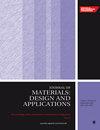Processing of crack-free Nickel- and Cobalt-based wear protection coatings and defined surfaces by subsequent milling processes
IF 2.2
4区 材料科学
Q3 MATERIALS SCIENCE, MULTIDISCIPLINARY
Proceedings of the Institution of Mechanical Engineers, Part L: Journal of Materials: Design and Applications
Pub Date : 2024-07-23
DOI:10.1177/14644207241265778
引用次数: 0
Abstract
In the area of plant engineering, steel components are provided with a wear protection coating for efficient use to protect them against corrosive, tribological, thermal and mechanical stresses. The use of innovative ultrasound-assisted milling processes and plasma-welded nickel- and cobalt-based wear protection coatings are being investigated to determine how more favourable machinability can be achieved while retaining the same wear protection potential. The focus is on the NiCrSiFeB alloy, which is intended to replace CoCr alloys in the area of screw machines. The utilization of ultrasonic-assisted milling for the machining of coating materials is a novel approach. The modification of hard facing layers in terms of microstructure and precipitation morphology as well as suitability for machining is investigated and compared with the CoCr alloy. The alloy modifications are generated by a PTA process by systematically adjusting the preheating and interpass temperatures, a crack-free wear-resistant layer can be generated, which is subsequently machined by a milling process. In addition to the crack-free properties, the microstructure, the bonding as well as the mixing between the NiCrSiFeB alloy and a 1.8550 as well as between the CoCr alloy and a 1.4828 are analysed and compared in the joining areas. In addition, heating and cooling rates are determined and a chemical analysis of the weld metals is performed. Furthermore, it was found that the build-up layers of NiCrSiFeB alloy are more difficult to machine using the milling process than the CoCr alloy, as higher milling forces are required.通过后续铣削工艺加工无裂纹镍基和钴基耐磨保护涂层和限定表面
在设备工程领域,钢制部件需要使用耐磨涂层,以有效保护其免受腐蚀、摩擦、热和机械应力的影响。目前正在研究如何使用创新的超声辅助铣削工艺和等离子焊接镍基和钴基磨损保护涂层,以确定如何在保持相同磨损保护潜力的同时实现更有利的可加工性。研究的重点是镍铬硅铁硼合金,这种合金将在螺杆机领域取代钴铬合金。利用超声波辅助铣削加工涂层材料是一种新方法。研究了硬质面层在微观结构和沉淀形态方面的改性以及加工适用性,并与 CoCr 合金进行了比较。合金改性是通过 PTA 工艺生成的,通过系统地调整预热和中间温度,可以生成无裂纹的耐磨层,然后通过铣削工艺进行加工。除了无裂纹特性外,还分析并比较了镍铬硅铁硼合金和 1.8550 镍铬合金之间以及钴铬合金和 1.4828 镍铬合金之间在连接区域的微观结构、结合和混合情况。此外,还确定了加热和冷却速度,并对焊接金属进行了化学分析。此外,还发现镍铬硅铁硼合金的堆积层比 CoCr 合金更难使用铣削工艺加工,因为需要更高的铣削力。
本文章由计算机程序翻译,如有差异,请以英文原文为准。
求助全文
约1分钟内获得全文
求助全文
来源期刊

CiteScore
4.70
自引率
8.30%
发文量
166
审稿时长
3 months
期刊介绍:
The Journal of Materials: Design and Applications covers the usage and design of materials for application in an engineering context. The materials covered include metals, ceramics, and composites, as well as engineering polymers.
"The Journal of Materials Design and Applications is dedicated to publishing papers of the highest quality, in a timely fashion, covering a variety of important areas in materials technology. The Journal''s publishers have a wealth of publishing expertise and ensure that authors are given exemplary service. Every attention is given to publishing the papers as quickly as possible. The Journal has an excellent international reputation, with a corresponding international Editorial Board from a large number of different materials areas and disciplines advising the Editor." Professor Bill Banks - University of Strathclyde, UK
This journal is a member of the Committee on Publication Ethics (COPE).
 求助内容:
求助内容: 应助结果提醒方式:
应助结果提醒方式:


